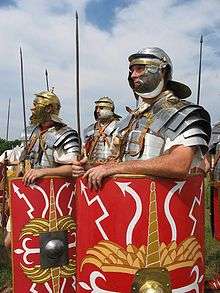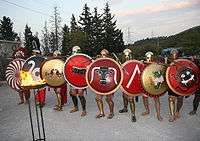Classical reenactment
Classical reenactment tends to focus on portrayals of the Greco-Roman world, and especially on modern recreations of Roman legions and ancient Greek hoplites.
Roman reenactment

Most groups that concentrate on Roman reenacting focus on one particular Roman legion; nearly all of the legions portrayed actually existed historically, and the reenactors strive to recreate the legion as accurately as possible. This attention to realism generally extends to the equipment worn and displayed, and to behavior displayed to each other and especially to the public; indeed, many public demonstrations attempt to recreate Roman military drills, marches, and even stage mock battles.
Roman reenactment groups usually welcome women and children, in an effort to both accommodate entire families and to portray Roman civilian life. Additionally, it is not unknown for older male reenactors (who might have previously played Roman legionaries) to portray consuls, senators, or even a Roman emperor.
The Roman Army did not remain static and, whilst sometimes demonstrating these changes in displays of the evolving equipment and appearance of the legionary, most groups also focus on a particular time period. The most popular period is probably the 1st-2nd century, with legionaries wearing the characteristic segmented armour illustrated on Trajan's Column. However, some groups portray the Late Roman legion, after the army reforms of Diocletian. A minority of groups depict the eastern continuance of the empire after the fall of Rome in the west, known popularly as the Byzantine Empire.
Roman reenacting is popular in both the United States and Europe.
Roman gladiator reenactment
A smaller subset of Roman reenactors attempt to recreate Roman gladiator troupes. Some of these groups are part of larger Roman reenactment groups, and others are wholly independent, though they might participate in larger demonstrations of Roman reenacting or historical reenacting in general. These groups usually focus on portraying mock gladiatorial combat in as accurate a manner as possible.
Ancient Greek reenactment

Greek reenacting groups concentrate mostly on classical era hoplites, though the Archaic, Hellenistic and Mycenaean eras are becoming popular as well. Most reenactors focus on Greek hoplites and tend to depict the classical era, particularly the period around the Peloponnesian wars, but accurate depictions of Greeks in the earlier Mycenaean and other eras has becoming increasingly more common, especially the era of Persian War and reenactments of the Macedonian phalanx. Aside from groups, there are also individuals who sometimes reenact the heroes of ancient Greece.
International conventions are now being held, with the first being in Watford, Britain in the summer of 2006.
Some groups stage mock battles such as the Spartan warband that equips its members with durable aspis and other period equipment, reenacting Phalanx formation tactics to their fullest extent by depicting two hoplite squads of reenactors clashing with each other. The Spartan Army is very popular as a theme, as can be evidenced by the group called the The Hellenic Warriors, who appear at museums, schools, and universities on the east coast of the United States.
Greek reenacting is popular in the United States, Europe and Australia and whose members from around the world will gather at the 2010 International Ancient Greek Hoplite Festival.
Celtic reenactment
Continenal and insular Celts and Gauls are the subjects of some reenacting groups, with a focus on anything from tribal warfare to even domestic re-enactment of Pre-Roman Celtic societies. Many specific tribes are being re-enacted, as are important events such as battles and festivals. Typically, Celtic groups are sister groups to a Roman legion, and are sometimes created originally to portray the Roman invasion of Gaul under Julius Caesar.